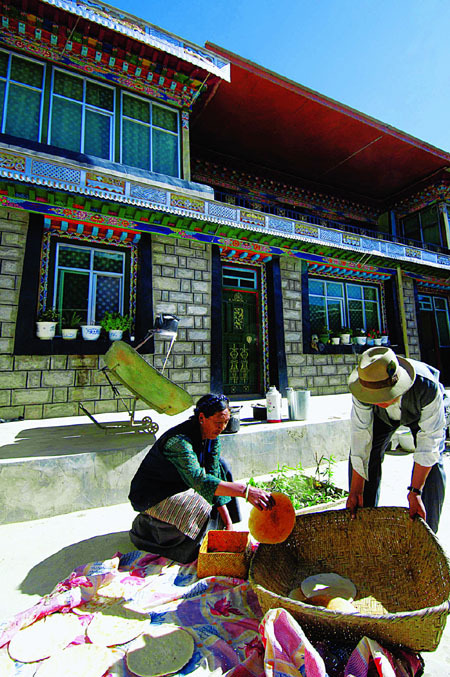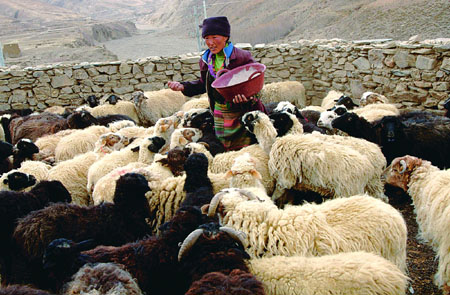| Tibet is an area where agriculture and animal husbandry are the dominant industries. Among the population of 2.81 million, more than 2.30 million are farmers and herders, accounting for over 80 percent of the total. Tibet's GDP has been increasing by over 12 percent each year. In the first five years of the 21st century, per capita GDP surpassed US$1,000, and per capita income of farmers and herders maintained double-digit growth for three straight years. According to statistics, in 2006, per capita disposable income of urban residents reached 8,941 Yuan, up 6.3 percent over the previous year, while per capita net income of farmers and herders totaled 2,435 Yuan, an increase of 17.2 percent. The Engel coefficient of urban and rural households was 50.2 percent and 53 percent, respectively.
Housing Project
Starting from January 2006, Tibet implemented an economic housing project for farmers and herders, which mainly included settlement of nomadic herders, poverty reduction and rebuilding farmers's houses. In that year alone, Tibet's various prefectures and cities invested 2.838 billion Yuan to finish building and rebuilding houses for 47,000 households and enabled 250,000 farmers and herders to move into new homes.
The housing project for farmers and herders is carried out through '"governmental support, other provinces'aid, bank loans and public self-financing". Every farmer and herder family or poverty-stricken household can draw assistance ranging from 10,000 to 25,000 Yuan, reducing the house-building costs of farmers and herders to the maximum extent. In rebuilding, the choice and living customs of the farmers and herders are fully respected.

Thanks to efforts made by the Tibetan government, many farmers and herders have moved into new houses. Picture shows a new house built for Tibetan farmer family.
With the implementation of the housing project for farmers and herders, the construction of the supporting projects financed by governments at various levels is also speeded up. In 2006, another 123 villages belonging to 12 townships gained highway access, 210,000 people enjoyed access to electricity, 320,000 farmers and herders gained drinking water meeting the State clean standards, and 1,064 administrative villages were linked by telephone.
In 2007, Tibet planned to invest 620 million Yuan to complete the housing project for 52,112 households of farmers and herders, and, at the same time, spend 141 million Yuan to finish the construction of infrastructure and integrated support projects for 600 administrative villages. The target is to enable over 80 percent of farmers and herders, totaling 219,800 households, to live in comfortable, safe housing within five years. According to preliminary estimates, the total investment for finishing the housing project for farmers and herders will surpass 10 billion Yuan.
Poverty-Reduction-Oriented Development
Starting from 2005, Tibet carried out pilot poverty reduction of "enhancing the whole township". It chooses 10 townships each year as pilots, each of which receives 3 million Yuan, which is mainly used for industrial development in the poverty-stricken townships or towns in addition to improving the production and living conditions of the poverty-stricken population. In 2006, Tibet continued to increase the input into the housing project for poor households, and implemented the projects for enhancing the whole township and industry-driven poverty reduction. These markedly improved the living quality of farmers and herders. The number of those with per capita income below 1,300 Yuan was reduced from 373,000 to 320,000, and the number of low-income population cut from 960,000 to 850,000.
In 2007, Tibet planned to expand the poverty-reduction program of "enhancing the whole township" and gradually establish the new farmers and herders training mechanism including "training, employment and service", creating a new situation for poverty-reduction projects. It allocated 193.044 million Yuan for poverty elimination. Based on the work of 20 experimental units of "enhancing the whole township", it planned to invest 45.8 million Yuan in carrying out poverty reduction in another 10 townships (towns). On the basis of improving planning, the townships (town) will focus on implementing projects such as domestic breeding, farmers and herders family's hostels, farmers and herders construction team, farming and livestock products processing and economic cooperation organizational support. The program will enhance the consciousness of farmers and herders towards commodities and expand the channel for increasing income.

Tibet gives more aid and support to special agricultural items so that farmers could have more earnings. A Tibetan woman farmer is feeding her sheep.
During the period from 2006 to 2010, the unique-industry-driven and "enhancing the whole township" poverty reduction programs will be implemented in Tibet's 200 townships (towns), mainly supporting 964,000 people. It ensures that one million people will be lifted out of poverty and backwardness and become rich, of whom 500,000 will be expected to take the lead in becoming well-off.
Drinking Water Safety in the Rural Areas
Unsafe drinking water in Tibet's farming and pasturing areas is a problem obsessing Tibetan locals. Long-distance water-carriage and unsafe water have influenced local health for a long time. In 2006, Tibet invested 230 million Yuan for a drinking water safety project in rural areas to provide potable water for over 300,000 people.
In 2007, Tibet gave priority to arranging the construction of the drinking water projects in housing projects, high-arsenic, high-fluorine, high-Kaschin-Beck disease-occurrence areas and border areas, and for minorities with small populations. Efforts will be made to ensure another 300,000 locals have access to potable water. By 2010, Tibet will offer safe drinking water to 1.222 million people. |





